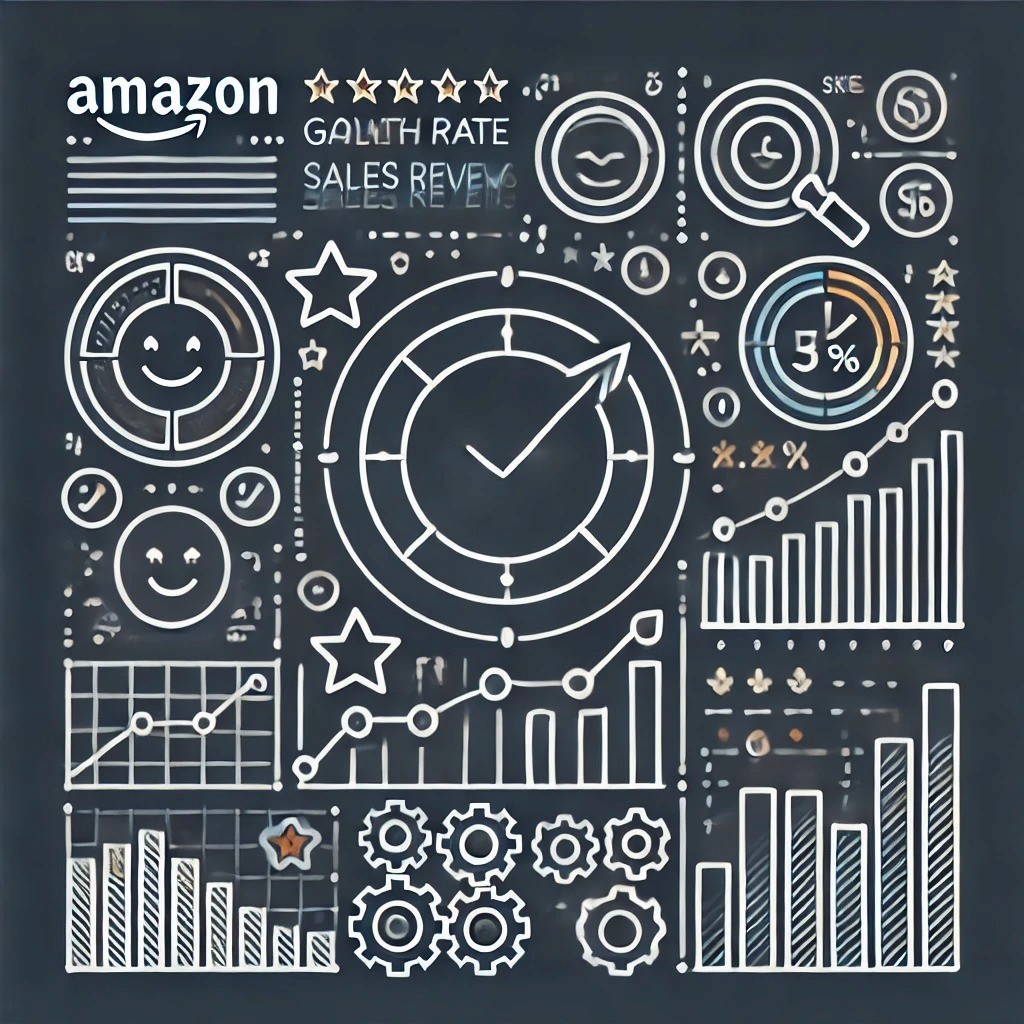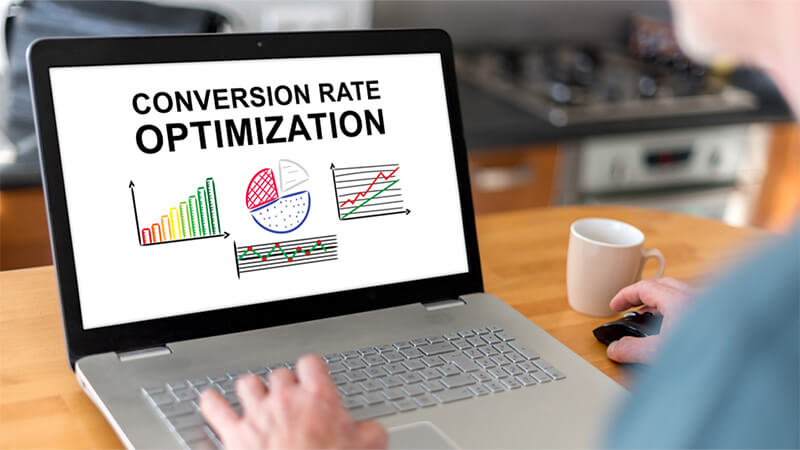Back to Page
Amazon
Discover The Kpis That Top Amazon Sellers Are Using To Skyrocket Their Success
Discover The Kpis That Top Amazon Sellers Are Using To Skyrocket Their Success


Back to Page
Amazon
Discover The Kpis That Top Amazon Sellers Are Using To Skyrocket Their Success

Apr 2, 2024
Get ready for an eye-opening journey where we spill the beans on the metrics and strategies that set the champs apart from the rest. If you're serious about dominating the Amazon game, you won't want to miss this ride!
When it comes to selling online, understanding and optimizing Key Performance Indicators (KPIs) is vital to success, and it’s no different for e-commerce giant Amazon. Your store’s KPIs offer you a detailed look into your business at any given moment highlighting areas where your store is excelling and those that need improvement. By closely watching and acting on these KPIs, you can make your store more visible, keep your customers happier, and sell more products. Dive into Amazon’s KPIs and actionable tips for each that allow you to take control and push your store to the front.
What is Amazon's KPI?

Key Performance Indicators (KPIs) are measurable data points that sellers can use to gauge how well they’re doing on Amazon. They cover the full spectrum of the selling lifecycle from portfolio and inventory management through customer engagement and promotional effectiveness. Understanding and ensuring that they’re refining their KPIs, sellers can do thorough Amazon product listing optimization to deliver the best possible experience to customers, and that their Amazon PPC advertising strategies are driving more sales at greater profitability.
#1: Inventory Performance Index

Your Inventory Performance Index (IPI) measures your effectiveness and efficiency in managing your FBA inventory. The better you manage your inventory, the more Amazon will make it available to supply your customer demand, and the lower your FBA fees will be.
Tips to improve IPI:
Keep an eye on your inventory performance frequently and adjust for sales trends.
Reduce your excess inventory overage — there’s no reason to incur long-term storage fees unless you have to.
Most importantly, don’t miss a restock after you sell out of one of your popular products.
#2: Order Defect Rate

The Amazon Order Defect Rate (ODR) is a vital measure of seller performance on the platform, reflecting the percentage of orders that are impacted by defects (e.g. damaged, missing, incorrect items, etc.). A high ODR is a sure sign of frequent customer returns — as well as dissatisfaction — which can utterly destroy the operational efficiency and reputation of a seller. Conversely, a low ODR means loads of happy and typically loyal customers. In other words, service delivery is worthy of a positive standing on the United States’ largest e-commerce platform. Given its obvious importance for seller success, ODR impacts — directly and indirectly — customer trust and right along with it, their Amazon visibility.
How to improve your ODR:
Address feedback and customer questions quickly to raise satisfaction and loyalty, which is key to reducing negative reviews — as well as their ODR impact.
Offer quick, free, and reliable shipping, which will lessen returns and complaints and will positively impact ODR.
During peak periods, you’ll also want to make sure efficient fulfillment is your aim — as it will keep delays and errors at bay and thus enhance satisfaction and ODR.
Finally, make sure dull packages are a relic of the past. Strong and efficient packaging will lessen transit damage and returns directly, which will have a corresponding impact on ODR.
#3: Product reviews and seller feedback

Customer reviews and seller feedback are influential. More and better ratings increase a product’s visibility and affect a shopper’s willingness to buy. Positive seller feedback and reviews make a product more visible and more appealing to potential buyers.
Here are tips for improving reviews and feedback:
Encourage satisfied customers to leave positive product reviews. Remind them to do it, make it easy by including a hyperlink, or ask if they need help leaving a review.
Address negative seller feedback quickly and professionally. Apologize and try to make things right.
Customers ultimately leave negative feedback because their product didn’t meet quality or accuracy expectations. Make sure your products are high quality and accurately described; fit and finish must match your description.
#4: Return rate

The rate of returns you get is a key KPI to monitor. High return rates will damage your seller's reputation and bottom line. To help get that number down, keep your customers happy and make sure your products marry up to the descriptions that they read before buying.
Here's how to reduce the return rate:
Make sure that your products have great descriptions and that all have plenty of high-quality images. Customers need to know exactly what they're buying.
Make your return policy easy for your customers -- no, make that super easy -- and make sure that it's simple for them to find and easy to understand.
Investigate why your products are being returned. Are there recurring issues that you can do something about?
#5: Conversion rate

One of the primary KPIs you’re going to track is your conversion rate. With a higher number of people buying your products, your listings are more attractive and you make both your organic and sponsored ads more effective.
Here's how to beef up your conversion rate:
Optimize product titles, descriptions, and images. Amazon’s recommendation may be different from one specific page to another, use capable Amazon optimization services to find the most effective!
A/B test until you have the most effective elements on your pages.
Compete on price but still take the earnings to the bank. The bank is another KPI and a very important one!
Product reviews, low return rates, and better conversion will be fundamental to your pursuit of optimizing Amazon KPIs.
#6: TACoS, RoAS, and ACoS

Total Advertising Cost of Sale (TACoS), Return on Ad Spend (RoAS), and Advertising Cost of Sale (ACoS) are critical advertising metrics that any seller should know at any given time to see how efficiently they are running their advertising.
Tips to Improve TACoS, RoAS, and ACoS:
Optimize ad campaigns with relevant keywords and appeal to relevant audiences.
Periodically review and modify bids and advertising strategies.
Focus on top-performing products rather than trying to get mediocre products to perform well.
#7: Click-Through Rate (CTR)

Click-through rate (CTR) indicates how much attention a particular ad is receiving — the higher it is, the more engaged people are with your ads and potential candidates for your product.
Tips to improve CTR:
Use compelling images and titles in your ads.
Ensure that your ads are being targeted at the right keywords and audiences.
Test different ad placements and formats to see what works for you.
#8: Buy Box

From a seller’s point of view, getting a place at the Amazon Featured Offer (formerly the Amazon Buy Box) is of the utmost importance for thriving on Amazon. According to price optimization and tracking software Feedvisor, the Buy Box accounts for 82 percent of sales on Amazon and increases the chance of getting the sale when a potential customer clicks “Add to Cart.”
To win the Buy Box, Amazon says that they must maintain a high order volume, sell products with a competitive low price, and maintain item in-stock levels.
Tips to win the Buy Box:
Offer competitive pricing.
Maintain a high level of inventory and order fulfillment efficiency.
Make sure your seller metrics are great, such as having a low ODR and high customer satisfaction percentage.
Conclusion
Understanding the most important Amazon KPIs is an absolute necessity for any Amazon seller looking to truly excel. The better you can understand and improve these KPIs the more you will be able to improve your visibility, customer satisfaction, and ultimately your sales and profitability. Focus on inventory management, customer feedback (you want your feedback rating as close to 100% as possible), conversion rates (which tie directly to sales), advertising efficiency (watch the ACoS in Seller Central), and winning the Buy Box. This will all require continuous improvement and adjustments. It’s not a set-it-and-forget-it type of game, and you must constantly be paying attention to what is happening in the marketplace, and making changes based on data. Feel free to consult eStore Factory’s comprehensive set of Amazon marketing services to accelerate your growth.
Get ready for an eye-opening journey where we spill the beans on the metrics and strategies that set the champs apart from the rest. If you're serious about dominating the Amazon game, you won't want to miss this ride!
When it comes to selling online, understanding and optimizing Key Performance Indicators (KPIs) is vital to success, and it’s no different for e-commerce giant Amazon. Your store’s KPIs offer you a detailed look into your business at any given moment highlighting areas where your store is excelling and those that need improvement. By closely watching and acting on these KPIs, you can make your store more visible, keep your customers happier, and sell more products. Dive into Amazon’s KPIs and actionable tips for each that allow you to take control and push your store to the front.
What is Amazon's KPI?

Key Performance Indicators (KPIs) are measurable data points that sellers can use to gauge how well they’re doing on Amazon. They cover the full spectrum of the selling lifecycle from portfolio and inventory management through customer engagement and promotional effectiveness. Understanding and ensuring that they’re refining their KPIs, sellers can do thorough Amazon product listing optimization to deliver the best possible experience to customers, and that their Amazon PPC advertising strategies are driving more sales at greater profitability.
#1: Inventory Performance Index

Your Inventory Performance Index (IPI) measures your effectiveness and efficiency in managing your FBA inventory. The better you manage your inventory, the more Amazon will make it available to supply your customer demand, and the lower your FBA fees will be.
Tips to improve IPI:
Keep an eye on your inventory performance frequently and adjust for sales trends.
Reduce your excess inventory overage — there’s no reason to incur long-term storage fees unless you have to.
Most importantly, don’t miss a restock after you sell out of one of your popular products.
#2: Order Defect Rate

The Amazon Order Defect Rate (ODR) is a vital measure of seller performance on the platform, reflecting the percentage of orders that are impacted by defects (e.g. damaged, missing, incorrect items, etc.). A high ODR is a sure sign of frequent customer returns — as well as dissatisfaction — which can utterly destroy the operational efficiency and reputation of a seller. Conversely, a low ODR means loads of happy and typically loyal customers. In other words, service delivery is worthy of a positive standing on the United States’ largest e-commerce platform. Given its obvious importance for seller success, ODR impacts — directly and indirectly — customer trust and right along with it, their Amazon visibility.
How to improve your ODR:
Address feedback and customer questions quickly to raise satisfaction and loyalty, which is key to reducing negative reviews — as well as their ODR impact.
Offer quick, free, and reliable shipping, which will lessen returns and complaints and will positively impact ODR.
During peak periods, you’ll also want to make sure efficient fulfillment is your aim — as it will keep delays and errors at bay and thus enhance satisfaction and ODR.
Finally, make sure dull packages are a relic of the past. Strong and efficient packaging will lessen transit damage and returns directly, which will have a corresponding impact on ODR.
#3: Product reviews and seller feedback

Customer reviews and seller feedback are influential. More and better ratings increase a product’s visibility and affect a shopper’s willingness to buy. Positive seller feedback and reviews make a product more visible and more appealing to potential buyers.
Here are tips for improving reviews and feedback:
Encourage satisfied customers to leave positive product reviews. Remind them to do it, make it easy by including a hyperlink, or ask if they need help leaving a review.
Address negative seller feedback quickly and professionally. Apologize and try to make things right.
Customers ultimately leave negative feedback because their product didn’t meet quality or accuracy expectations. Make sure your products are high quality and accurately described; fit and finish must match your description.
#4: Return rate

The rate of returns you get is a key KPI to monitor. High return rates will damage your seller's reputation and bottom line. To help get that number down, keep your customers happy and make sure your products marry up to the descriptions that they read before buying.
Here's how to reduce the return rate:
Make sure that your products have great descriptions and that all have plenty of high-quality images. Customers need to know exactly what they're buying.
Make your return policy easy for your customers -- no, make that super easy -- and make sure that it's simple for them to find and easy to understand.
Investigate why your products are being returned. Are there recurring issues that you can do something about?
#5: Conversion rate

One of the primary KPIs you’re going to track is your conversion rate. With a higher number of people buying your products, your listings are more attractive and you make both your organic and sponsored ads more effective.
Here's how to beef up your conversion rate:
Optimize product titles, descriptions, and images. Amazon’s recommendation may be different from one specific page to another, use capable Amazon optimization services to find the most effective!
A/B test until you have the most effective elements on your pages.
Compete on price but still take the earnings to the bank. The bank is another KPI and a very important one!
Product reviews, low return rates, and better conversion will be fundamental to your pursuit of optimizing Amazon KPIs.
#6: TACoS, RoAS, and ACoS

Total Advertising Cost of Sale (TACoS), Return on Ad Spend (RoAS), and Advertising Cost of Sale (ACoS) are critical advertising metrics that any seller should know at any given time to see how efficiently they are running their advertising.
Tips to Improve TACoS, RoAS, and ACoS:
Optimize ad campaigns with relevant keywords and appeal to relevant audiences.
Periodically review and modify bids and advertising strategies.
Focus on top-performing products rather than trying to get mediocre products to perform well.
#7: Click-Through Rate (CTR)

Click-through rate (CTR) indicates how much attention a particular ad is receiving — the higher it is, the more engaged people are with your ads and potential candidates for your product.
Tips to improve CTR:
Use compelling images and titles in your ads.
Ensure that your ads are being targeted at the right keywords and audiences.
Test different ad placements and formats to see what works for you.
#8: Buy Box

From a seller’s point of view, getting a place at the Amazon Featured Offer (formerly the Amazon Buy Box) is of the utmost importance for thriving on Amazon. According to price optimization and tracking software Feedvisor, the Buy Box accounts for 82 percent of sales on Amazon and increases the chance of getting the sale when a potential customer clicks “Add to Cart.”
To win the Buy Box, Amazon says that they must maintain a high order volume, sell products with a competitive low price, and maintain item in-stock levels.
Tips to win the Buy Box:
Offer competitive pricing.
Maintain a high level of inventory and order fulfillment efficiency.
Make sure your seller metrics are great, such as having a low ODR and high customer satisfaction percentage.
Conclusion
Understanding the most important Amazon KPIs is an absolute necessity for any Amazon seller looking to truly excel. The better you can understand and improve these KPIs the more you will be able to improve your visibility, customer satisfaction, and ultimately your sales and profitability. Focus on inventory management, customer feedback (you want your feedback rating as close to 100% as possible), conversion rates (which tie directly to sales), advertising efficiency (watch the ACoS in Seller Central), and winning the Buy Box. This will all require continuous improvement and adjustments. It’s not a set-it-and-forget-it type of game, and you must constantly be paying attention to what is happening in the marketplace, and making changes based on data. Feel free to consult eStore Factory’s comprehensive set of Amazon marketing services to accelerate your growth.
Get ready for an eye-opening journey where we spill the beans on the metrics and strategies that set the champs apart from the rest. If you're serious about dominating the Amazon game, you won't want to miss this ride!
When it comes to selling online, understanding and optimizing Key Performance Indicators (KPIs) is vital to success, and it’s no different for e-commerce giant Amazon. Your store’s KPIs offer you a detailed look into your business at any given moment highlighting areas where your store is excelling and those that need improvement. By closely watching and acting on these KPIs, you can make your store more visible, keep your customers happier, and sell more products. Dive into Amazon’s KPIs and actionable tips for each that allow you to take control and push your store to the front.
What is Amazon's KPI?

Key Performance Indicators (KPIs) are measurable data points that sellers can use to gauge how well they’re doing on Amazon. They cover the full spectrum of the selling lifecycle from portfolio and inventory management through customer engagement and promotional effectiveness. Understanding and ensuring that they’re refining their KPIs, sellers can do thorough Amazon product listing optimization to deliver the best possible experience to customers, and that their Amazon PPC advertising strategies are driving more sales at greater profitability.
#1: Inventory Performance Index

Your Inventory Performance Index (IPI) measures your effectiveness and efficiency in managing your FBA inventory. The better you manage your inventory, the more Amazon will make it available to supply your customer demand, and the lower your FBA fees will be.
Tips to improve IPI:
Keep an eye on your inventory performance frequently and adjust for sales trends.
Reduce your excess inventory overage — there’s no reason to incur long-term storage fees unless you have to.
Most importantly, don’t miss a restock after you sell out of one of your popular products.
#2: Order Defect Rate

The Amazon Order Defect Rate (ODR) is a vital measure of seller performance on the platform, reflecting the percentage of orders that are impacted by defects (e.g. damaged, missing, incorrect items, etc.). A high ODR is a sure sign of frequent customer returns — as well as dissatisfaction — which can utterly destroy the operational efficiency and reputation of a seller. Conversely, a low ODR means loads of happy and typically loyal customers. In other words, service delivery is worthy of a positive standing on the United States’ largest e-commerce platform. Given its obvious importance for seller success, ODR impacts — directly and indirectly — customer trust and right along with it, their Amazon visibility.
How to improve your ODR:
Address feedback and customer questions quickly to raise satisfaction and loyalty, which is key to reducing negative reviews — as well as their ODR impact.
Offer quick, free, and reliable shipping, which will lessen returns and complaints and will positively impact ODR.
During peak periods, you’ll also want to make sure efficient fulfillment is your aim — as it will keep delays and errors at bay and thus enhance satisfaction and ODR.
Finally, make sure dull packages are a relic of the past. Strong and efficient packaging will lessen transit damage and returns directly, which will have a corresponding impact on ODR.
#3: Product reviews and seller feedback

Customer reviews and seller feedback are influential. More and better ratings increase a product’s visibility and affect a shopper’s willingness to buy. Positive seller feedback and reviews make a product more visible and more appealing to potential buyers.
Here are tips for improving reviews and feedback:
Encourage satisfied customers to leave positive product reviews. Remind them to do it, make it easy by including a hyperlink, or ask if they need help leaving a review.
Address negative seller feedback quickly and professionally. Apologize and try to make things right.
Customers ultimately leave negative feedback because their product didn’t meet quality or accuracy expectations. Make sure your products are high quality and accurately described; fit and finish must match your description.
#4: Return rate

The rate of returns you get is a key KPI to monitor. High return rates will damage your seller's reputation and bottom line. To help get that number down, keep your customers happy and make sure your products marry up to the descriptions that they read before buying.
Here's how to reduce the return rate:
Make sure that your products have great descriptions and that all have plenty of high-quality images. Customers need to know exactly what they're buying.
Make your return policy easy for your customers -- no, make that super easy -- and make sure that it's simple for them to find and easy to understand.
Investigate why your products are being returned. Are there recurring issues that you can do something about?
#5: Conversion rate

One of the primary KPIs you’re going to track is your conversion rate. With a higher number of people buying your products, your listings are more attractive and you make both your organic and sponsored ads more effective.
Here's how to beef up your conversion rate:
Optimize product titles, descriptions, and images. Amazon’s recommendation may be different from one specific page to another, use capable Amazon optimization services to find the most effective!
A/B test until you have the most effective elements on your pages.
Compete on price but still take the earnings to the bank. The bank is another KPI and a very important one!
Product reviews, low return rates, and better conversion will be fundamental to your pursuit of optimizing Amazon KPIs.
#6: TACoS, RoAS, and ACoS

Total Advertising Cost of Sale (TACoS), Return on Ad Spend (RoAS), and Advertising Cost of Sale (ACoS) are critical advertising metrics that any seller should know at any given time to see how efficiently they are running their advertising.
Tips to Improve TACoS, RoAS, and ACoS:
Optimize ad campaigns with relevant keywords and appeal to relevant audiences.
Periodically review and modify bids and advertising strategies.
Focus on top-performing products rather than trying to get mediocre products to perform well.
#7: Click-Through Rate (CTR)

Click-through rate (CTR) indicates how much attention a particular ad is receiving — the higher it is, the more engaged people are with your ads and potential candidates for your product.
Tips to improve CTR:
Use compelling images and titles in your ads.
Ensure that your ads are being targeted at the right keywords and audiences.
Test different ad placements and formats to see what works for you.
#8: Buy Box

From a seller’s point of view, getting a place at the Amazon Featured Offer (formerly the Amazon Buy Box) is of the utmost importance for thriving on Amazon. According to price optimization and tracking software Feedvisor, the Buy Box accounts for 82 percent of sales on Amazon and increases the chance of getting the sale when a potential customer clicks “Add to Cart.”
To win the Buy Box, Amazon says that they must maintain a high order volume, sell products with a competitive low price, and maintain item in-stock levels.
Tips to win the Buy Box:
Offer competitive pricing.
Maintain a high level of inventory and order fulfillment efficiency.
Make sure your seller metrics are great, such as having a low ODR and high customer satisfaction percentage.
Conclusion
Understanding the most important Amazon KPIs is an absolute necessity for any Amazon seller looking to truly excel. The better you can understand and improve these KPIs the more you will be able to improve your visibility, customer satisfaction, and ultimately your sales and profitability. Focus on inventory management, customer feedback (you want your feedback rating as close to 100% as possible), conversion rates (which tie directly to sales), advertising efficiency (watch the ACoS in Seller Central), and winning the Buy Box. This will all require continuous improvement and adjustments. It’s not a set-it-and-forget-it type of game, and you must constantly be paying attention to what is happening in the marketplace, and making changes based on data. Feel free to consult eStore Factory’s comprehensive set of Amazon marketing services to accelerate your growth.









